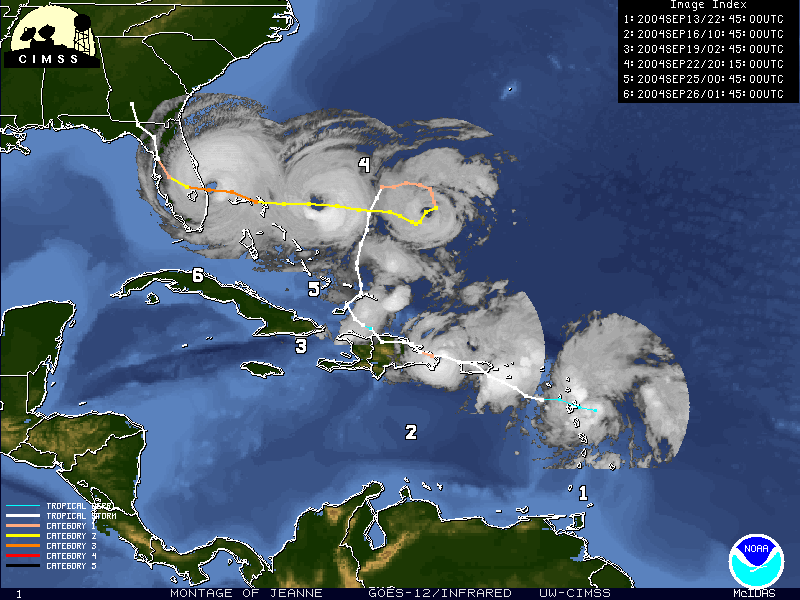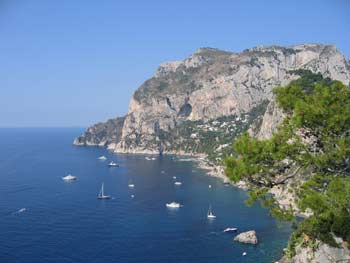Monthly News Summary – October 2004
Hurricanes Redux
Terri Gregory, Editor
This issue of In the News covers SSEC news and events from September 2004. Use images freely with credit to the Space Science and Engineering Center, University of Wisconsin–Madison. Jennifer O’Leary wrote all of Weather Research and most of Meetings. Either she or Terri Gregory wrote all other pieces, unless otherwise noted.
In August, with hurricanes churning across the Atlantic to Florida, the Tropical Cyclones Web site logged 10 million hits. For all of September, more than 53 million hits were scored! And the tropical storms discussions (a semiofficial news group for hurricane forecasters and researchers) continues to show the National Hurricane Center’s and National Weather Service’s reliance on products developed by CIMSS, especially the Objective Dvorak Technique.
Popular Research Products—The popularity of Gary Wade’s hurricane montages has led to development of a new automated product. The Tropical Cyclone Research Team recently created a product that compiles snapshot images of a storm to display its path in one image. Additionally, these montages include a color-coded progression of the storm’s intensity.
SSEC’s MODIS Direct Broadcast Facility also received and processed spectacular images of the season’s hurricanes through Ivan (September 16).
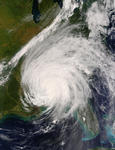 |
Hurricane Ivan after Florida landfall, September 16, 2004. See the MODIS Gallery for more hurricane images. |
For the near future, this is unfortunately the last MODIS imagery available from SSEC’s Direct Broadcast Facility. The computer used to process the data has met with an untimely accident. A replacement or fix is in the works, perhaps by the time you read this. Besides the many media appearances noted in September 2004 In the News, Chris Velden also spoke on Madison’s WIBA radio and spoke with Canadian Broadcast Corporation reporters. UW–Madison’s Why Files used CIMSS images in a hurricane feature story and presented CIMSS hurricane research and told how researchers handle the data. Every week, Why Files, a a World Wide Web magazine funded by NSF and published by University Communications, covers a science story inspired by the headlines. On September 4, Alan Sealls, WKRG-TV’s Chief Meteorologist, used McIDAS developer Rick Kohrs’s high resolution animation of Hurricane Frances in their 5 p.m. newscast. WKRG-TV is the CBS affiliate in Mobile. Sealls estimates that they had more than 50,000 viewers during that broadcast.
The official UW–Madison newspaper, Wisconsin Week, featured the movie of Hurricane Frances on September 8 as a new “satellite animation tool.” London, England’s TV Channel 4 asked to use the “rather fabulous movie” of Hurricane Ivan on their 7 p.m. news on September 10.
In “Shelter from the Storm,” the Economist magazine (September 18, 2004) examines the current state of hurricane forecasting. “… [S]ubstantial improvements have been made over the past 30 years,” they say, but note that predicting intensity is still “hardly better” than in 1974. Knowing more about the eyewall, where winds are most intense, would help. James Kossin, of SSEC’s CIMSS Tropical Cyclones group, saw his predictions of vortices in the eye of Hurricane Isabel realized in 2003. The behavior is important because it makes clear that the eye is not symmetrical as many researchers had assumed. Jason Dunion, of the National Hurricane Center, works with CIMSS using satellite data to study the Saharan air layer off the Sahara Desert that Atlantic storms interact with. This “layer inhibits the intensification of storms.” Other groups also study hurricane intensity—NOAA’s Hurricane Research Division, Colorado State University’s CIRA, the University of Miami and Ohio’s Kent State University.
Data and Imagery
As seen in the Spotlight on the SSEC front page, MODIS true color imagery clearly shows the vivid transition to “Autumnal Fire” vegetation colors in northern Wisconsin. Scott Bachmeier provides an animation of 7 days during September and October. Thom Benson of WRCB TV’s Channel 3 Storm Alert Team will show first and last images to his audience in Chattanooga, Tennessee. He notes, “The gallery images are awesome.”
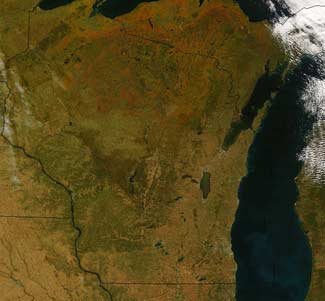 |
Wisconsin, October 9, 2004 through MODIS imagery. |
The UCAR Quarterly newsletter uses SSEC’s global montage in the background of a picture in an article about COMET, the Cooperative Program for Operational Meteorology Education and Training.
Engineering Feats
ICDS—The Wisconsin Engineer, a magazine published by UW–Madison College of Engineering students, features IceCube and AMANDA neutrino telescopes in the September 2004 issue. The article noted that a special hot water drill needed to be made for the deep holes that will be drilled for IceCube. SSEC’s Ice Coring and Drilling Service provides the expertise for the drill.
A-HSRL—The Arctic HSRL has moved out of its testing position in the building’s penthouse and has begun operations in the Arctic Circle, near Barrow, Alaska.
Field Experiments and Meetings
Scanning HIS Experiments, by Robert Knuteson—The Scanning HIS team recently returned from a successful set of back-to-back experiments in Europe namedADRIEX (Italy) and EAQUATE (England). The experiments were performed September 6 through 18, 2004, using the Scaled Composites Proteus aircraft. The Scanning HIS team had three objectives for this deployment: intercompare Scanning HIS upwelling infrared radiances with those of the NPOESS Atmospheric Sounder Testbed – Interferometer (NAST-I, to fly on future polar-orbiting weather satellites) on the same aircraft; intercompare radiances with the UK Meteorology Office ARIES instrument during wingtip-to-wingtip flights with the BAE146 aircraft; underfly the NASA “A-train” of satellites which currently includes both Aqua (temperature and water sounder) and Aura (atmospheric chemistry). The team successfully overcame numerous obstacles to accomplish their objectives but with the help of Paolo Antonelli (formerly of CIMSS, soon to be with the Mediterranean Agency for Remote Sensing) the language and cultural barrier in Italy was successfully bridged. In England, repair of a leaky fuel pump caused some delays with the aircraft but all objectives were eventually accomplished. A photo of the grueling conditions encountered by participants on a day trip to Capri is included for your enjoyment.
Presentations at AMS Satellite Conference—CIMSS and ASPB claim credit for many of the poster presentations and papers at the 13th American Meteorological Society’s (AMS) Conference on Satellite Meteorology and Oceanography held on September 20-23. The theme was “Next Generation Environment Sensors and Emerging Applications in Satellite Meteorology and Oceanography.” The presentations at the conference focused on advances in the uses of a broad array of new sensors and innovative plans for the future. Robert Holz, CIMSS graduate student (Ph.D.), was awarded second place for his poster presentation on Scanning-HIS data analysis.
MUG-ed—On October 7 and 8, SSEC hosted the 2004 McIDAS User’s Group (MUG) Meeting. Participants learned how various sites used their McIDAS systems as well as recent technological advances. Of particular interest were cloud productsdeveloped by NASA’s Langley Research Center to be used by pilots. The merged CONUS cloud product shows cloud conditions in a variety of phase states—icy, water, others across the U.S.—all developed in McIDAS. MUG meeting attendees also had a chance to hear about plans for the future, and a panel of McIDAS users played a devilishly difficult and clever game of GEOpardy. Meeting presentations will be posted on the MUG Web site.
Weather experts in training—On September 27 and 28, CIMSS hosted a meeting to critique and continue the development of plans for the Satellite Hydrology and Meteorology (SHyMet) training course. The meeting resulted in a revised plan and a set of action items.
Science Experts
Contrails—Steve Ackerman appears with a NASA scientist in a video on contrails, or condensation trails. Produced by Discoveries and Breakthroughs Inside Science, the piece was aired by local stations in more than 100 U.S. television markets, possibly reaching 65 million viewers. The piece shows how contrails become cirrus clouds and trap Earth’s radiated energy. The piece suggests that changing flight paths could prevent or at least decrease their buildup. The American Institute of Physics produces these videos with help from NewsProNet, the National Science Foundation, and other scientific societies.
The Weather Guys, by Jennifer A. O’Leary—The Weather Guys continue their monthly rendezvous with Larry Meiller on his WHA Radio call-in show. On September 27, as they have for the past five years, Professors Steve Ackerman and Jonathan Martin once again explained the mysteries of the weather to Wisconsin Public Radio listeners.
In light of this summer’s tropical activity, many callers posed questions dealing with hurricanes. Ackerman and Martin described what limits a hurricane’s strength as well as how jet streams “impose their will” on a hurricane’s path. The Guys also addressed the accuracy of hurricane forecasting technology. In spite of many advances allowing earlier, more accurate predications, Ackerman pointed out that “we can’t forecast the re-intensification of the eye wall.”
After revisiting summer storms, fall colors became a recurring topic of conversation. A caller wanted to know why New England foliage seemed more vibrant than that of Wisconsin. Ackerman and Martin said certain areas in Wisconsin exhibit more color than others and that a “lack of trees in other parts of the state … make it look less vibrant.” The Weather Guys reminded the audience that they aren’t arborists, but agreed with a caller that perhaps the types of trees in a given area contribute to the vibrancy of fall colors.
With September rapidly coming to a close, the show soon turned to a discussion of winters past and present. Although September has been the hottest month this year and evidence shows a bit of an El Niño effect developing, both of the Guys seem to think, or at least hope, that this winter will bring snow and cold temperatures.
WPR archives shows from the past year on their Web site. Tune in to 970AM or listen online for The Weather Guys on the last Monday of every month from 11:45-12:30.
Weather Research
Spinning Satellite Images—The CIMSS Tropical Cyclone Group recently produced a new tool to monitor structure and intensity changes in tropical cyclones. The Morphed anImated Microwave Imagery (MIMI) algorithm compiles tropical cyclone imagery from five satellite instruments to create an animation that helps scientists and forecasters see the timing of the eye-wall replacement cycles. To account for the complex motion properties of a cyclone, MIMI imposes an advection scheme on the microwave signal. The scheme, a function of the cyclone’s radius and reported wind speed, blends the averaged satellite images while rotating them to create the morphed animation. During Hurricane Ivan, the National Hurricane Center (NHC) had a chance to try out the MIMI algorithm. “It really helps to see the evolution of banding features and how the low-level convergence patterns change,” Stacey Stewart with NHC said.
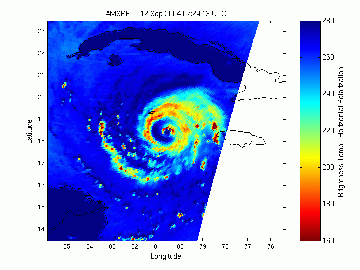 |
Aqua image of Hurricane Ivan from September 12, 2004, one of the images used to make the morphed animation |
A breath of fresh air—On September 8, CIMSS researchers Tony Wimmers and Scott Bachmeier discussed the Infusing satellite Data into Environmental Applications (IDEA) project with staff from the Wisconsin Department of Natural Resources’sBureau of Air Management. They focused on techniques for interpreting true color MODIS data and on MODIS aerosol products. They also looked at validating chemical transport models with MODIS data to improve air quality at protected locations. State air quality forecasters offered suggestions on how to improve the IDEA Web site and product suite.
Canada picks up MODIS technology—On September 21, the Canadian Meteorological Centre (CMC) incorporated the MODIS polar winds product into their forecast system. The European Center for Medium-Range Forecasts (ECMRF), NASA’s Global Modeling and Assimilation Office (GMAO), and the Japan Meteorological Agency (JMA) all use this technology in numerical weather prediction. The MODIS polar winds product has had a positive impact on weather forecasts in both polar and extratropical regions.
Papers
Clouds at night – In a collaborative effort, Yinghui Liu, Jeff Key, Richard Frey, Steve Ackerman and Paul Menzel recently published a paper (.pdf) in Remote Sensing of Environment. The paper, “Nighttime polar cloud detection with MODIS,” presents new cloud detection tests that use water vapor data and carbon dioxide bands.
Education, Outreach
The SSEC course “Satellite Meteorology for Grades 7–12” has been added to the NESDIS Education and Outreach page under Educational Resources.
In the Wings
Writer Visits—SSEC will host UW–Madison Writer in Residence Joel Swerdlow for lunch and a tour on November 8. Swerdlow has written for National Geographic and leading newspapers around the country and will be on campus for that week. Room 823 is reserved starting at 11:30 a.m. and all in the Atmospheric, Oceanic and Space Sciences building are invited to join him for a brown-bag lunch. During the week, Swerdlow will talk to journalism classes and give public lectures.
Also of Note
The Candidates Speak—Even if did take them months to respond, Kerry and Bush campaign organizations answered questions that Science magazine posed to them. The answers reveal how either administration would treat certain scientific and research areas, such as space and climate. See Science, Vol. 306, 1 October 2004. The AIP lists more resources.
Cloud Stamps—The U.S. Postal Service released a new series of cloud stamps and post cards on October 4. The Postal Service collaborated with The Weather Channel, the American Meteorological Society and the National Weather Service in a combined stamp and postcard release, featuring 15 different stamps showing 9 different cloud types.
A recent Site of the Day (refdesk.com) is “a ‘Guide to the Most Efficient Things in the World,’ with reviews and information on everything from LED lightbulbs, translucent eco-resins, HVAC, bikes and biodegradable carpets to ceramics, rainwater harvesting, non-toxic kids’ toys, household electronics, etc.” Isthmus writer David Medaris provided this useful site.

